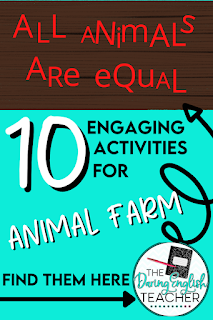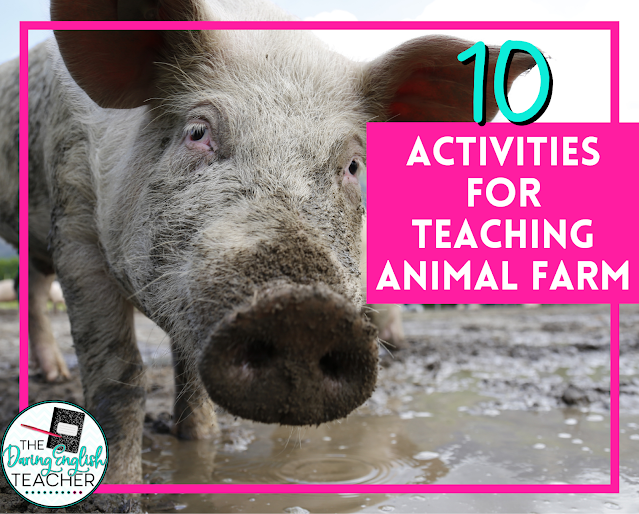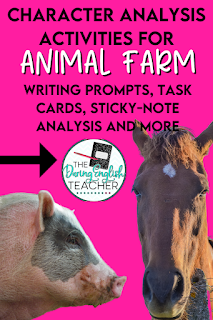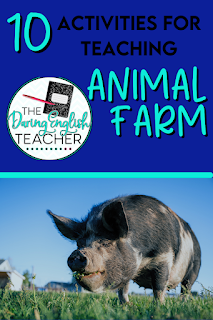Animal Farm is such an “easy” read, but it’s also important and packed with themes and civics-related topics to discuss. If you’re looking for new ideas for teaching Animal Farm, read on. I’m excited to share these 10 activities with you.
10 Activities for Teaching Animal Farm
1. Group Research Project
Instead of having a bunch of independent work for students to complete, get them into groups to share the load of research. This is perfect for switching up the monotony of worksheets and independent work. You can also use this as a differentiated option if you have students who may benefit from tackling research as a group rather than on their own. My group research project includes a final project of 5 paragraph essay with MLA formatting and a PowerPoint presentation. It’s an engaging option to set the historical context before reading Animal Farm OR you can use it as an extension activity after the novel.
2. Vocabulary Study
Having a grasp on the vocabulary is an important place to start with novel studies. Building useful vocabulary skills is honestly just something I feel is important in general for not only making meaningful connections, but it’s something students can continue to use beyond the unit. If you’re adding a vocabulary unit to your Animal Farm unit, consider this resource full of puzzles, quizzes, differentiated columns, and vocabulary terms for each chapter.
3. Chapter Writing Prompts
Second to vocabulary, I like to focus on characters. There are a lot of ways to go about character studies, but being an allegory, Animal Farm has a lot of great depth. Engage students with a variety of activities and writing prompts. Studying characters from a variety of angles is a great way to make sure students understand, and that you are helping students who need differentiated instruction. There are a lot of different activities you can do for character studies. You can look at rhetorical analysis, characterization, argument writing, allegory, and irony. I have an engaging writing prompt activity that covers all this and more.
4. Argument Essay
Being able to construct a good argument essay means students can investigate a topic, collect and evaluate their evidence, and establish a concise position. The allegory of Animal Farm is such a perfect novel to study argument writing and let students write their own. Check out this final argument essay that includes 2 rubrics and peer editing options, as well as essay outlines, graphic organizers, and a thesis generator to aid students in nailing the argument essay.
5. Speech Study
Major’s speech is a pivotal moment in Animal Farm. It is what inspires the rebellion and brings the animals together. His rhetorical skill is a perfect example to study speeches and help students understand ethos, pathos, and logos. If you’re not sure where to begin with a speech study project, I have five different activities that I use to help students understand and analyze Major’s speech. My packet includes excerpts for annotating, worksheets for key ideas, and explanations of ethos, pathos, logos, and the rhetorical triangle.
6. Character Analysis
Back to the characters with an analysis activity. There are so many characters in the novel and they all stand-in for the broader metaphor. Put together an analysis activity that will help students keep track of the characters and their purpose, as well as any other notes they may need to understand the text deeply. Think about the characterization from all angles. You can have students focus on whether characters are round or flat, static or dynamic, the main conflict for the character, and whether they are an antagonist or protagonist. But you can also go deeper and look at emotional development and motivation from the beginning of the novel to the end. Find both of these analysis options here.
7. Sticky Note Analysis
I’m a little bit obsessed with the sticky notes. First, they are super fun to bring out. There are color and shape options to offer variety to students. They offer a level of interaction. They are also a great way to guide students to be concise with their wording and thoughts when completing activities. Check out my Sticky Note Literary Analysis Activities for 11 organizers that can be used at any point in the novel. These are so perfect to help scaffold literary analysis. Five of my organizers also include built-in writing prompts.
8. Interactive Bookmarks
Looking for something simple and compact? Literally? Use bookmarks. They fit in the book and so serve a purpose as a bookmark. If students have their novels with them in class, they already have their work with them too. You can use a bookmark to study characters, list important quotes, create timelines of events, answer quiz questions, and more. I personally love this foldable bookmark that houses a variety of activities. I use three different bookmarks over the course of Animal Farm. Each is double-sided and has space for all of my activities. You can see it in action here.
9. Short Responses and Task Cards
When you have task cards or short response activities, it opens up a variety of activities you can use. You can have students work on each aspect independently or in groups. You can easily adjust the wording to scaffold the learning for students. If you want students to get up and more around, you can make the task cards a gallery walk on craft paper. You can graffiti wall any short writing response. You can put questions on strips glued to Jenga tiles and have students play the game and answer as they go. This resource includes six detailed and higher-level response questions in a couple of different formats: writing task cards, discussion task cards, and paper-saving handouts.
10. Self-Graded Quizzes
Oh yeah, self-grading quizzes. I created these to run on Google Forms, and each chapter has a quiz. If you’re looking for something different to assess if students read the chapters, or you need some assessments for students working remotely, go grab this resource. It really takes the pressure off handling paper materials (also a great option if you’re looking for a greener classroom), it’s quick and super-efficient. Did I mention it also gathers the data into a Google Sheet for you? Still needing a paper option? Don’t worry, the resource comes with this option as well.
I love adding to my own toolbox with ideas to spruce up novel studies. What are your favorite activities when working with Animal Farm that your students love?




